🔗 Configuring a Squid Server to authenticate against Kerberos
by Markus Moeller
Need to extract linked images and embed them
🔗 Outline
Two helpers are bundled with the Squid sources:
-
negotiate_kerberos_authfor Squid running on Unix/Linux systems -
mswin_negotiate_auth.exeffor Squid running on Windows systems
The following documentation applies to the helper Unix/Linux systems. The Windows helper doesnot need any kind of configuration, it works just out of the box.
🔗 Pre-requisites for Active Directory integration
Install msktutil package from http://fuhm.net/software/msktutil/ or https://code.google.com/p/msktutil/, or install Samba
🔗 krb5.conf Configuration
In IE the proxy must be specified as FQDN not as an IP-address

rc4-hmacshould be listed as encryption type for windows 2003.
A minimal setup without DNS resolution of AD servers would be (MIT Kerberos example):
[libdefaults]
default_realm = WIN2003R2.HOME
dns_lookup_kdc = no
dns_lookup_realm = no
default_keytab_name = /etc/krb5.keytab
; for Windows 2003
default_tgs_enctypes = rc4-hmac des-cbc-crc des-cbc-md5
default_tkt_enctypes = rc4-hmac des-cbc-crc des-cbc-md5
permitted_enctypes = rc4-hmac des-cbc-crc des-cbc-md5
; for Windows 2008 with AES
; default_tgs_enctypes = aes256-cts-hmac-sha1-96 rc4-hmac des-cbc-crc des-cbc-md5
; default_tkt_enctypes = aes256-cts-hmac-sha1-96 rc4-hmac des-cbc-crc des-cbc-md5
; permitted_enctypes = aes256-cts-hmac-sha1-96 rc4-hmac des-cbc-crc des-cbc-md5
;
; for MIT/Heimdal kdc no need to restrict encryption type
[realms]
WIN2003R2.HOME = {
kdc = w2k3r2.win2003r2.home
admin_server = w2k3r2.win2003r2.home
}
[domain_realm]
.linux.home = WIN2003R2.HOME
.win2003r2.home = WIN2003R2.HOME
win2003r2.home = WIN2003R2.HOME
[logging]
kdc = FILE:/var/log/kdc.log
admin_server = FILE:/var/log/kadmin.log
default = FILE:/var/log/krb5lib.log
🔗 Create keytab
-
Create keytab for HTTP/fqdn with msktutil. (If used together with samba net join use another computer name than the hostname used by net join)
kinit administrator@DOMAIN msktutil -c -b "CN=COMPUTERS" -s HTTP/<fqdn> -h <fqdn> -k /etc/squid/HTTP.keytab --computer-name squid-http --upn HTTP/<fqdn> --server <domain controller> --verboseor for Windows 2008 for AES support
msktutil -c -b "CN=COMPUTERS" -s HTTP/<fqdn> -h <fqdn> -k /etc/squid/HTTP.keytab --computer-name squid-http --upn HTTP/<fqdn> --server <domain controller> --verbose --enctypes 28 ```

has Windows Netbios limitations of 15 characters. 
msktutilrequires thecyrus-sasl-gssapildap plugin to authenticate to AD ldap.because of a bug in
msktutil0.3.16 the <computer-name> must be lowercase
OR with Samba
- Join host to domain with net ads join
- Create keytab for HTTP/fqdn with net ads keytab
kinit administrator@DOMAIN
export KRB5_KTNAME=FILE:/etc/squid/HTTP.keytab
net ads keytab CREATE
net ads keytab ADD HTTP
unset KRB5_KTNAME
Do not use this method if you run winbindd or other samba services as samba will reset the machine password every x days and thereby makes the keytab invalid !
OR with MIT/Heimdal kdamin tool
🔗 Squid Configuration File
Paste the configuration file like this:
auth_param negotiate program /usr/sbin/squid_kerb_auth
auth_param negotiate children 10
auth_param negotiate keep_alive on
The basic auth ACL controls to make use of it are:
acl auth proxy_auth REQUIRED
http_access deny !auth
http_access allow auth
http_access deny all
Add the following to the squid startup script (Make sure the keytab is readable by the squid process owner e.g. chgrp squid /etc/squid/HTTP.keytab; chmod g+r /etc/squid/HTTP.keytab )
KRB5_KTNAME=/etc/squid/HTTP.keytab
export KRB5_KTNAME
Kerberos can keep a replay cache to detect the reuse of Kerberos tickets (usually only possible in a 5 minute window) . If squid is under high load with Negotiate(Kerberos) proxy authentication requests the replay cache checks can create high CPU load. If the environment does not require high security the replay cache check can be disabled for MIT based Kerberos implementations by adding the following to the startup script
KRB5RCACHETYPE=none
export KRB5RCACHETYPE
🔗 Troubleshooting Tools
On Windows clients (e.g. IE or Firefox on XP, 2003, etc) use kerbtray
or klist from Microsoft resource kit to list and purge tickets.
Wireshark traffic on port 88 (Kerberos) to identify Kerberos errors.
(KRB5KDC_ERR_PREAUTH_REQUIRED is not an error, but an informational
message to the client)
🔗 Further references
- A nice HOWTO is available at http://klaubert.wordpress.com/2008/01/09/squid-kerberos-authentication-and-ldap-authorization-in-active-directory/
🔗 Step by Step Overview
- User login to Desktop
- From Windows PC to Windows Active Directory as user <userid> selecting Netbios domainname DOMAIN
- From Unix PC using kinit or pam to Windows Active Directory as user <userid@DOMAIN.COM>
- From Windows PC to Unix Key Distribution Centre (KDC) as <userid> selecting Netbios domainname DOMAIN
- From Unix PC using kinit or pam to Unix Key Distribution Centre (KDC) as user userid@DOMAIN.COM
- Any of the above will create an AS Request/AS Reply exchange

- User requests URL from Squid
- Send GET or PUT or any other request via Squid
- Squid (if setup correctly) replies with Proxy-Authenticate:
Negotiate
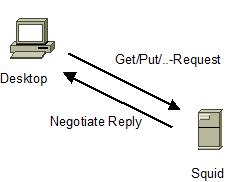
-
Desktop attempts to get a Service ticket HTTP/<squid-fqdn> from KDC as user < userid@DOMAIN.COM >

-
Desktop sends request to Squid
- With Proxy-Authorization: Negotiate <base64 encoded Kerberos token> if previous step 3. was successful
- With Proxy-Authorization: Negotiate <base64 encoded NTLM
token> if previous step 3. was not successful (not further
discussed here. See NTLM documentation)
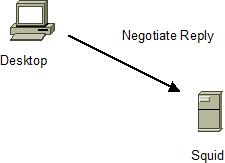
-
Squid verifies Kerberos ticket with help of keytab and replies after checking any additional access control settings The ticket contains the the user detail < userid@DOMAIN.COM > and squid can do authorisation decision based on it
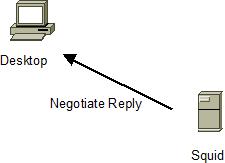
-
Step 2., 4. and 5. continue until the Kerberos cache with the received AS and TGS replies expires after about 8 hours (This depends on your kdc settings and/or your kinit options) and step 1. and 3 need to be done again which is usually transparent on Windows but may require a new kinit on Unix.
If squid_kerb_ldap is used the following steps are happening
-
Squid “login” to Windows Active Directory or Unix kdc as user <HTTP/<fqdn-squid>@DOMAIN.COM>. This requires Active Directory to have an attribute userPrincipalname set to <HTTP/<fqdn-squid>@DOMAIN.COM> for the associated acount. This is usaully done by using msktutil.
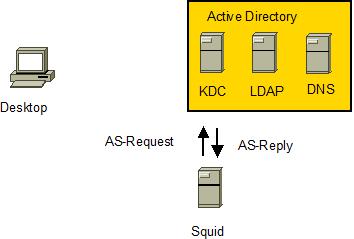
-
Squid determines ldap server from DNS by looking at SRV records
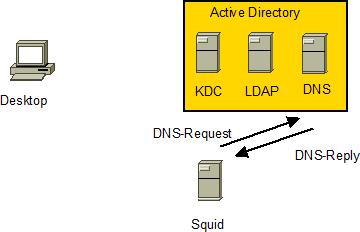
-
Squid connects to ldap server

-
If Kerberos authentication is supported by the ldap server Squid will request a service ticket <ldap/<ldap-server-fqdn> as user <HTTP/<squid-fqdn>@DOMAIN.COM>
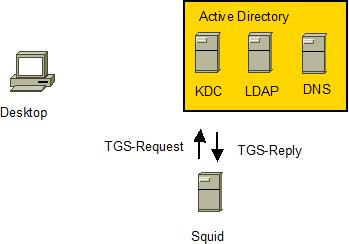
-
Squid sends LDAP search requests and receives replies using Kerberos authentication to the ldap server
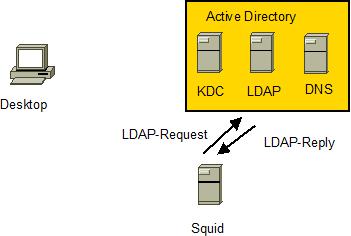
⚠️ Disclaimer: Any example presented here is provided "as-is" with no support
or guarantee of suitability. If you have any further questions about
these examples please email the squid-users mailing list.
Categories: ConfigExample
Navigation: Site Search, Site Pages, Categories, 🔼 go up